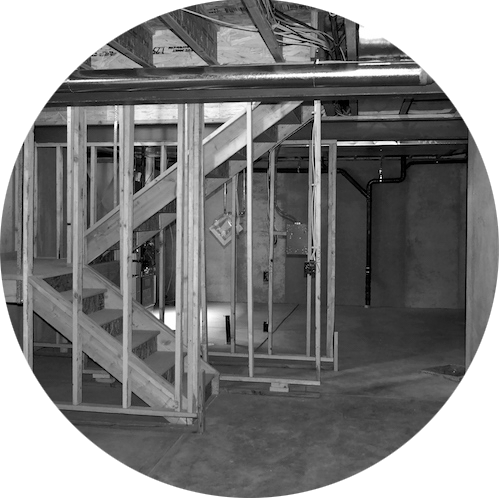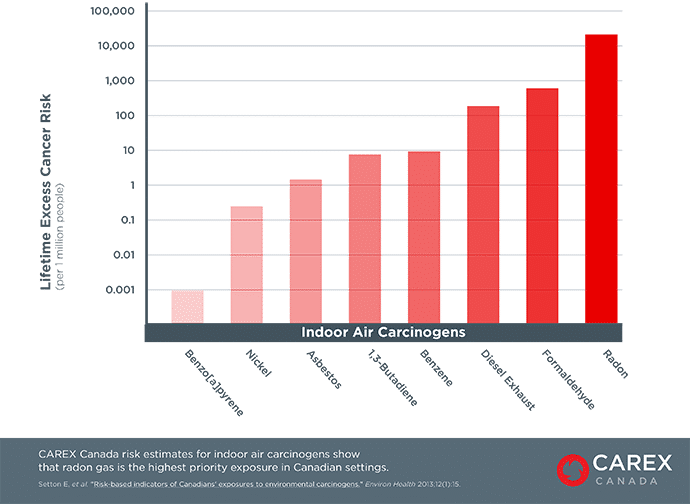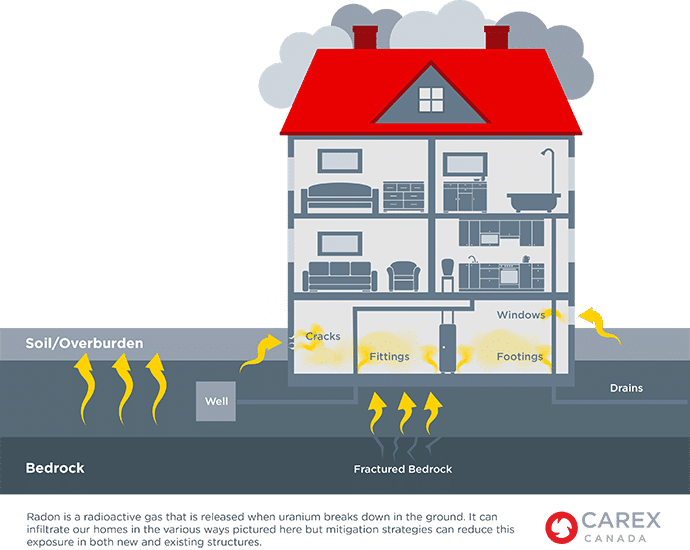Radon Profile

RADIATION – KNOWN CARCINOGEN (IARC 1)
Contents
Radon Profile
QUICK SUMMARY
- A naturally occurring radioactive gas produced when uranium in soils and rocks breaks down
- Associated cancer: Lung cancer
- Most important route of exposure: Inhalation
- Primary source: Enters and accumulates in buildings through unfinished floors, wall slab joints, sump pumps, windows, and cracks and openings in foundations
- Occupational exposures: Approx. 190,000 Canadians are occupationally exposed to radon; workers at risk of highest exposure are underground miners
- Environmental exposures: Found in public buildings, schools, hospitals, and new and older homes; levels are highest in indoor air and underground
- Fast fact: Radon is the second leading cause of lung cancer in Canada. People who smoke and are exposed to elevated levels of radon have an even higher risk of lung cancer.
General Information
Radon is a naturally occurring radioactive gas released when uranium in soils and rocks breaks down. It is colourless, tasteless, and odourless.[1] When radon decays it produces ionizing radiation as well as other species, which are referred to as radon daughters or progeny.[2] Radon is found in several isotopic forms; the two radon isotopes found at significant concentrations in the human environment are 222Rn and 220Rn (thoron).[1] 222Rn is the most important isotope of radon because 220Rn has a very short half-life.[1]
Radon and its decay products are ubiquitous in air, water, and soil. Radon may also be referred to as alphatron or nitron.[3]
Radon is classified by International Agency for Research on Cancer (IARC) as Group 1, carcinogenic to humans, with a well established link to lung cancer.[3] The 2012 IARC review of Group 1 carcinogens reaffirmed this classification.[4]
Several epidemiological studies show a causal relationship between occupational exposure to radon gas at high doses and an increased incidence of lung cancer.[1] Concurrent exposure to radon and cigarette smoke has a synergistic effect on the development of lung cancer.[5,6]
Using results from a 2012 residential radon survey of homes across the country, Health Canada estimated that 16% of lung cancer deaths (more than 3,200 cases/year) are attributable to radon exposure.[7]
Regulations and Guidelines
Occupational exposure limits (OEL)
The Canadian government has formulated a number of guidelines that provinces and territories can use when developing their own regulations. The Canadian Guidelines for the Management of Naturally Occurring Radioactive Materials (NORM) suggests an annual effective dose (AED) of 20 mSv for occupationally exposed workers, and 1 mSv for incidentally exposed workers.[8] The Government of Canada Radon Guideline suggests a maximum air concentration of radon within dwellings and public buildings (schools, hospitals, long term care facilities, correctional facilities, etc.) of 200 becquerels per cubic metre (Bq/m3).[9] The Canada Labour Code requires radon concentrations in indoor air to fall below 800 Bq/m3 in federal government workplaces (for non-nuclear energy workers).
The following tables summarize exposure guidelines set by various jurisdictions in Canada. Table 1 summarizes radon specific OELs, while Table 2 summarizes OELs for radiation that includes sources of radon. Prince Edward Island does not enforce any OEL for radon.[10]
Table 1. Radon specific OELs
| Canadian Jurisdiction | OEL (multiple units) |
|---|---|
| Federal: Canada Labour Code[11] | For non-nuclear energy workers: 800 Bq/m3 |
| MB[12], NL[13], NS[14] | 4 WLM/year (adopts the ACGIH guidelines); ALARA |
| NB[15,16] | Underground miners: 4.8 WLM/year, TWA cannot exceed 0.4 WL; ALARA Other workers: none |
| ON[17,18] | 4 WLM/year (adopts the ACGIH guidelines); Workers in mines and mining plants: 1 WLM; ALARA |
| YT[19] | All workers: AED = 1 WL; ALARA |
| Other | OEL |
| ACGIH 2020 TLV[20] | 4 WLM/year; ALARA |
ACGIH = American Conference of Governmental Industrial Hygienists
AED = annual effective dose
ALARA = measures must be taken to keep a worker’s exposure to a level as low as is reasonably achievable
Bq/m3 = Bequerels per cubic metre (bequerels: a measure of radioactivity)
mSv = milliSievert
TWA = time weighted average
WL = working level (concentration of radon progeny in 1 m3 of air that has a potential energy of 2.08×10-5J)
WLM = working level months (exposure that results from the inhalation of air containing one WL for 170 hours)
WLM/year = working level months per year
Table 2. Other OELs that include radon
| Canadian Jurisdiction | OEL (multiple units) |
|---|---|
| Federal[21] | Nuclear energy worker: AED = 50 mSv; Not a nuclear energy worker: AED = 1 mSv; ALARA |
| AB[22] | Radiation worker: AED = 50 mSv; Not a radiation worker: AED = 1 mSv; ALARA |
| BC[23] | AED = 20 mSv*; ALARA |
| NT & NU[24,25] | Nuclear energy worker: AED = 50 mSv; 100 mSv over any 5 year period; Not a nuclear energy worker: AED = 1 mSv; ALARA |
| QC[26] | Nuclear energy worker: AED=50 mSv, or on average 20 mSv/year for 5 years Not a nuclear energy worker: AED = 1 mSv; ALARA |
| SK[27] | Nuclear energy worker: AED=50 mSv, or 100 mSv over a 5 year period Not a nuclear energy worker: AED = 1 mSv; ALARA |
*Applies to all workers who are exposed to any source of ionizing radiation, except as otherwise noted
AED = annual effective dose
ALARA = measures must be taken to keep a worker’s exposure to a level as low as is reasonably achievable
mSv = milliSievert
Nuclear energy worker = worker who is exposed to radiation, and is likely to receive a dose of radiation in excess of the prescribed limit for members of the public
Radiation worker = a worker who uses or is directly involved in using ionizing designated radiation equipment or an ionizing radiation source
TWA = time weighted average
WL = working level
WLM = working level months
WLM/year = working level months per year
Canadian environmental guidelines
| Jurisdiction | Limit | Year |
|---|---|---|
| Government of Canada Radon Guideline | 200 Bq/m3 | 2009[28] |
Bq/m3 = Bequerels per cubic metre (bequerels: a measure of radioactivity)
Main Uses
Radon has no significant industrial purpose, but it is produced in small quantities for research purposes where it is used to initiate and influence chemical reactions.[1]
Radon was used historically to treat ulcers, allergies, arthritis, and tumors.[1] It is still used today for therapeutic purposes in some European countries, such as providing pain relief from rheumatoid arthritis.[29,30]
Environmental Exposures Overview
The most important route of radon exposure for the general population is inhalation. Exposure by ingesting drinking water is possible, but there is very little evidence that ingesting radon leads to cancer.[2] CAREX Canada estimates that radon in indoor and outdoor air are sources of elevated cancer risk in Canada (moderate data quality). In fact, risk estimates for indoor air carcinogens show that radon gas is the highest priority exposure in Canadian environmental settings.[31] Environmental radon exposure through indoor dust, drinking water, food, and beverages is considered negligible.

Radon levels are significantly higher in indoor air compared to outdoor air. In Canada, radon can be found in new and older homes and public buildings, such as hospitals, schools, care facilities, and detention centres.[32] Radon gas enters buildings when the air pressure inside is lower than in the soil surrounding the foundation.[33] This difference in pressure draws air and other gases, including radon, into buildings through cracks and openings in foundations, construction joints, gaps around pipes, sump pumps and drains, windows, or cavities inside walls. Radon can also be found in groundwater from private or small community wells. When this water is agitated through showering, clothes washing, and cooking, radon may be released into the home.[34]

Environmental radon concentrations vary depending on a number of factors including building characteristics (e.g. ventilation and sealing), occupant lifestyle (e.g. using windows or fireplaces), and local geology and soil characteristics.[33] The highest concentrations are found in areas with uranium and thorium ore deposits and granite formations (which have naturally high concentrations of uranium).[2] Radon levels in buildings also vary across seasons, and can change significantly in 24 hours (by a factor of two or three).[32] The highest levels usually occur in winter because windows and doors are kept closed, sealing buildings and therefore decreasing ventilation. When buildings are sealed to conserve energy, higher levels of radon can accumulate as well.[35]
Most Canadian homes contain some level of radon gas.[33] In a cross-country survey of radon concentrations in homes conducted by Health Canada from 2009 to 2011, 6.9% of homes tested had indoor radon concentrations above the current Canadian guideline of 200 Bq/m3.[36] Results indicate that radon levels vary significantly across the country. Indoor radon is more prevalent in a number of regions, but no areas of the country are ‘radon free’. Saskatchewan, Manitoba, New Brunswick, and the Yukon had the highest percentages of participant homes testing above the radon guideline.
Percent of home radon measurements above 200 Bq/m3 by health region
2009-2011 Cross Canada Radon Survey – Phase 1 & 2 results
On average, Canadians receive a typical yearly dose of about 1.0 mSv from inhaling radon and its decay products.[9] This dose varies greatly across the country according to the geological composition of the area; for example, in Vancouver the average dose is 0.2 mSv/year, but in Winnipeg it is 2.2 mSv/year.
For more information, see the environmental exposure estimate for radon.
Occupational Exposures Overview
Inhalation is the most important route of exposure in occupational settings.[2] Radon in groundwater, soil, or building materials may enter the work environment and decay into radioactive particles.[3,4] CAREX Canada estimates that approximately 190,000 Canadians are exposed to radon in the workplace. By industry, the largest exposed groups are elementary and secondary schools, provincial and territorial public administration, and universities. By occupation, the greatest exposures occur among administrative assistants, general office support workers, receptionists, and elementary school and kindergarten teachers.
Radon levels in confined or underground spaces (particularly in mines) are often elevated compared to outdoor air levels.[2,4] The highest exposed workers are those involved in underground mining, especially for uranium.[1] Other workers who spend time underground (e.g. subway and utility tunnel workers) are also at increased risk in areas where radon is present. Indoor workers of any type may also be exposed, especially if they work in areas and rooms with higher concentrations of radon (e.g. basements).
Other occupations with the potential for exposure to radon include remediation workers (especially of mine sites), phosphate fertilizer producers, researchers who use radon, and construction excavators.There is little information available on the occurrence of radon in Canadian workplaces. There are five active uranium mines in Canada; all are located in Saskatchewan. In 1998, high levels of radon were associated with propane production in British Columbia, with concentrations reaching as high as 4,958 Bq/m3.[37] In Nova Scotia, radon concentrations were collected over a three month period from 21 workplaces that had high potential for radon exposure, including water treatment facilities and coal power stations. The maximum concentration measured was 202 Bq/m3.[38]
Occupational radon exposure measurement is mandated and managed by the Radiation Protection Bureau of Health Canada for uranium miners. This data is held in the National Dose Registry (NDR), which contains exposure data for workers exposed to radiation across Canada.[39]
According to the Burden of Occupational Cancer in Canada project, occupational exposure to radon leads to approximately 190 lung cancers each year in Canada, based on past exposures (1961- 2001).[40,41] This amounts to 0.8% of all lung cancers diagnosed annually. Radon exposure occurs very broadly across workers in many industries. The groups with the largest burden of radon-related cancers are finance, insurance, real estate and leasing; trade; mining and oil and gas extraction; and public administration. Work-related radon exposure resulted in approximately $185 million in costs for newly diagnosed lung cancer cases in 2011.[41]
For detailed estimates of exposure to radon, see the occupational exposures tab.
Exposure Reduction
The only way to know if radon levels are elevated is to test. Our Radon in Schools page provides a summary of research into efforts school testing efforts across Canada. The most effective method for decreasing indoor radon levels is active soil depressurization, which involves installing a fan and vent pipe in the basement floor to reverse the air pressure flow.[33] There are a number of other techniques that can reduce exposure to radon.
See the Resources tab for more information.
Sources
Photo: Flickr, Michael Buck
Subscribe to our newsletters
The CAREX Canada team offers two regular newsletters: the biannual e-Bulletin summarizing information on upcoming webinars, new publications, and updates to estimates and tools; and the monthly Carcinogens in the News, a digest of media articles, government reports, and academic literature related to the carcinogens we’ve classified as important for surveillance in Canada. Sign up for one or both of these newsletters below.
CAREX Canada
School of Population and Public Health
University of British Columbia
Vancouver Campus
370A - 2206 East Mall
Vancouver, BC V6T 1Z3
CANADA
As a national organization, our work extends across borders into many Indigenous lands throughout Canada. We gratefully acknowledge that our host institution, the University of British Columbia Point Grey campus, is located on the traditional, ancestral and unceded territories of the xʷməθkʷəy̓əm (Musqueam) people.


